 |
|
|
|

Days Three and Four of our Voyage of Discovery were dedicated to collecting the data the students would need to test their hypotheses. Some students collected data while the Half Moon was underway from New York Harbor past the Hudson Highlands, while others took advantage of our layover at Beacon, NY.
During the data collection phase, each student established a work schedule for gathering data, collected and analyzed samples, and recorded their findings.
You can scroll down or use the links below to jump directly to a section.
|
|
Comparative Temperatures
|
| 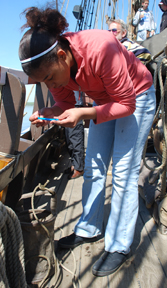 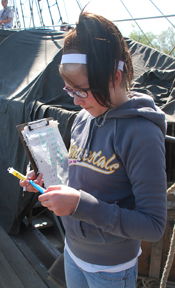
Students: Kristie & Sienna
Senior Crew Advisor: Virginia Mahigian
Instruments: Digital thermometer, wet thermometer, canvas bucket, Van Dorn sampler.
Starting on the night of Day Three and throughout Day Four, Kristie & Sienna took temperature readings from both the air (using a digital thermometer) and surface water samples (using a wet thermometer) drawn from the river with a canvas bucket. On Day Six, they also used a Van Dorn sampler to test temperatures within a water column. They recruited the rest of the student crew to help them gather data during anchor watch, allowing them to collect a full 24-hour cycle of comparative temperature readings.
|
Back to Top
|
|
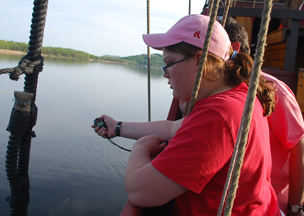 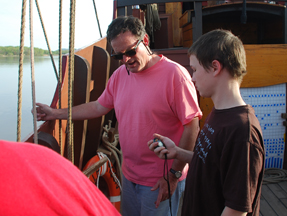
Students: Casey & Jesse
Senior Crew Advisor: Steve Linehan
Instruments: Lead line, wood biscuits, stopwatch.
When the Half Moon reached its layover destination on Day Four, Casey and Jesse spent the evening taking readings on the hour and half-hour of the current speed and direction of Athens Channel. On Day Five, they continued to record current speed throughout the tidal cycle.
|
|
Lines of Position
|
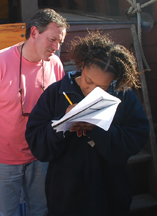 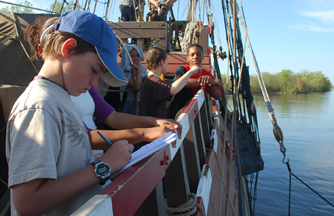
Students: Daniella & Jacob
Senior Crew Advisor: Captain William Reynolds (and the whole crew!)
Instruments: Directional compass (two varieties).
On Day Four, while the Half Moon was docked at Athens Channel, Daniella and Jacob recruited the entire crew for their project. They instructed each member of the crew in the use of two varieites of directional compass: hand-held and "puck" designs. Each crew member then used the techniques of lines of position to mark the bearings of two fixed marks: a beacon across the channel, and the lighthouse marking the southern end of the channel. The crew then secretly reported their findings to Daniella and Jacob, who will prepare a statistical analysis of the reported bearings.
|
Back to Top
|
Mechanical Advantage |
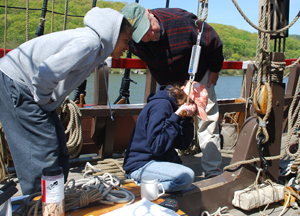 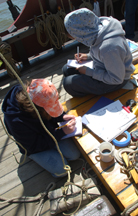
Students: Jasmine & Mary
Senior Crew Advisor: Ned Chalker
Instruments: Spring scale, lead ballast ingot, block & tackle system.
On Day Four, Mr. Chalker helped Jasmine & Mary erect a block & tackle-based simple machine on the weather deck. Jasmine and Mary then rigged this simple machine to lift a lead ingot 12" off the deck, using from one to four pulleys to do so. While one student lifted the weight, her partner read the attached spring scale to record the pounds of force required to lift the weight, as well as the distance they needed to pull the lead to achieve a repeated effect, and thus tested the mechanical advantage provided by the system.
|
Back to Top
|
Salinity |
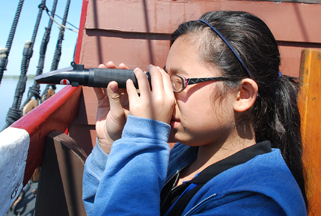 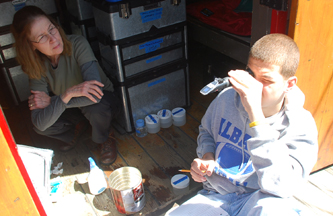
Students: Muhammad & Thwe-Thwe
Senior Crew Advisor: Mary Ellen Jacobs
Instruments: Canvas bucket, sample jars, GPS unit, refractometer.
Starting on Day Two, while still at anchor at the Bay Ridge Flats in New York Harbor, numerous student crew members collaborated to start collecting water samples using a simple canvas bucket. Muhammad, Thwe-Thwe, and their assistants continued collecting water samples as the Half Moon traveled upriver through Day Four. Muhammad and Thwe-Thwe then used a refractometer to measure the salinity levels of each sample, and will graph their findings.
|
|
Solar Energy
|
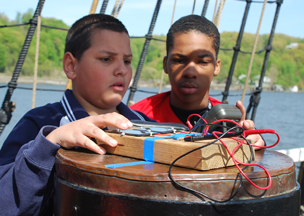 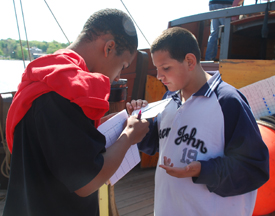
Students: Beniah & Keith
Senior Crew Advisor: Kipp van Aken
Instruments: Quadrant, compass, solar panel array, voltometer.
On Day Four, as the Half Moon traveled upriver, Beniah and Keith connected a voltometer to a fixed pair of horizontal solar panels to measure solar energy output. They also used a quadrant to measure the altitude of the sun and a compass to determine its direction. Readings were taken with increasing frequency as midday approached so Beniah and Keith could accurately determine the time of local true noon.
|
|
|
|
|
|
|
|
|

